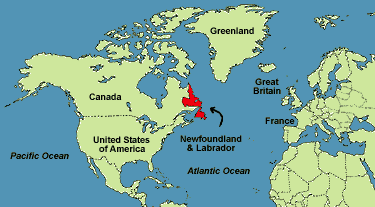Location and Information
Newfoundland and Labrador is located on the far north-eastern fringe of North America, closer to Europe than any other part of the continent. It is situated between the 46th and 61st parallels, with most of the island section of the province below the 50th parallel. The total land area of the province is 405,720 sq. km.; the island portion of the province, Newfoundland, covers 111,390 sq. km. while the mainland section, Labrador, covers 294,330 sq. km.

Illustration by Duleepa Wijayawardhana, 1998.
The province's proximity to the North Atlantic Ocean helps to give it a moderate climate. Two major currents, the Labrador Current from the Arctic and the Gulf Stream from the Gulf of Mexico flow past the province. The average winter temperatures on the island of Newfoundland range from -6°C to -10°C in the interior to a -2°C to -4°C on the south-east coast. In Labrador the average winter temperature is between -10°C and -15°C. The average summer temperature on the island is approximately 14°C in coastal areas, while inland the average temperature may go above 16°C. The average temperature in Labrador is between 8-10°C on the coast, with the temperature in the interior approximately 3-5°C warmer.
According to 1996 statistics, the total population of the province is 551,792; 522,602 people reside on the island of Newfoundland and 29,190 people in Labrador. Slightly more than half of Newfoundlanders and Labradorians live in rural communities along the province's rugged coastline. The rest of the population lives in the larger city and towns. The largest city is the capital, St. John's, with a population of 101,936 and a metro-area population of approximately 177,000.
The ethnic background of the people is predominantly British, particularly the south-west of England and the south-east of Ireland. English is the mother tongue of 98.6 percent of the people. However the province has a French presence, especially on the island's west coast, that accounts for 0.4 percent of the population. In addition to its European ancestry, the province is home to three native groups: the Innu, Inuit, and Mi'kmaq. The first two groups live in Labrador and the Mi'kmaq reside on the west-coast of the island. The native languages and other non-official languages account for the remaining 1 percent of the languages spoken in the province.
On March 31, 1949, the people of Newfoundland and Labrador joined Canada and became the country's youngest and most easterly province.




